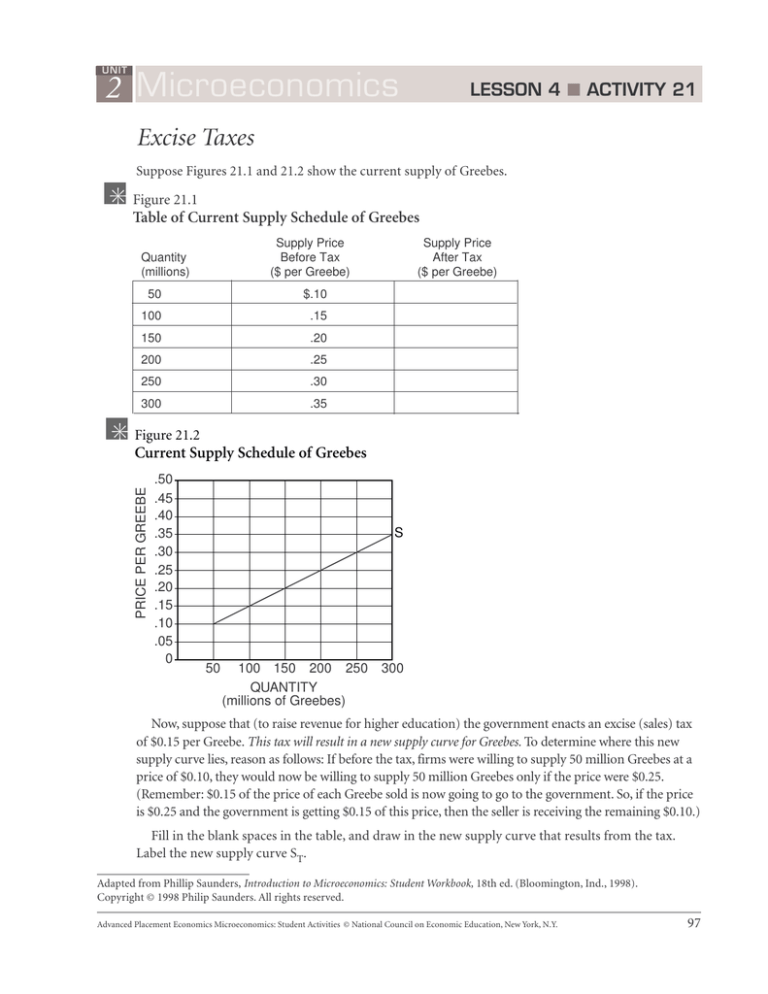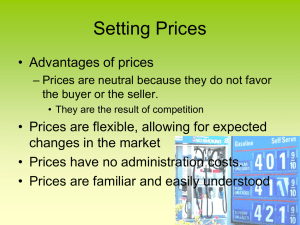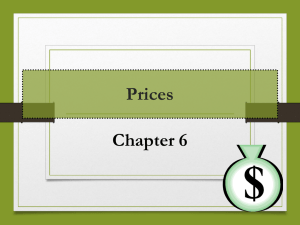2 Microeconomics Excise Taxes LESSON 4
advertisement

UNIT 2 Microeconomics LESSON 4 ACTIVITY 21 Excise Taxes Suppose Figures 21.1 and 21.2 show the current supply of Greebes. Figure 21.1 Table of Current Supply Schedule of Greebes Supply Price Before Tax ($ per Greebe) Quantity (millions) 50 $.10 100 .15 150 .20 200 .25 250 .30 300 .35 Supply Price After Tax ($ per Greebe) Figure 21.2 PRICE PER GREEBE Current Supply Schedule of Greebes .50 .45 .40 .35 .30 .25 .20 .15 .10 .05 0 S 50 100 150 200 250 QUANTITY (millions of Greebes) 300 Now, suppose that (to raise revenue for higher education) the government enacts an excise (sales) tax of $0.15 per Greebe. This tax will result in a new supply curve for Greebes. To determine where this new supply curve lies, reason as follows: If before the tax, firms were willing to supply 50 million Greebes at a price of $0.10, they would now be willing to supply 50 million Greebes only if the price were $0.25. (Remember: $0.15 of the price of each Greebe sold is now going to go to the government. So, if the price is $0.25 and the government is getting $0.15 of this price, then the seller is receiving the remaining $0.10.) Fill in the blank spaces in the table, and draw in the new supply curve that results from the tax. Label the new supply curve ST. Adapted from Phillip Saunders, Introduction to Microeconomics: Student Workbook, 18th ed. (Bloomington, Ind., 1998). Copyright © 1998 Philip Saunders. All rights reserved. Advanced Placement Economics Microeconomics: Student Activities © National Council on Economic Education, New York, N.Y. 97 UNIT 2 Microeconomics LESSON 4 ACTIVITY 21 (continued) What will be the result of this excise (sales) tax on the equilibrium quantity of Greebes? The equilibrium price paid by buyers (PB)? The equilibrium price received by sellers (PS)? The revenue received by the government? The income, or revenue, received by sellers after the tax? The answers to these important questions will depend on the nature of the demand for Greebes. The next section of this activity will help you determine the effects of a $0.15 excise tax on Greebes under four different demand conditions. Part A Figure 21.3 Relatively Inelastic Demand for Greebes as Compared with D1 on Figure 21.4 .50 PRICE PER GREEBE .45 .40 .35 S .30 .25 .20 .15 D .10 .05 0 50 100 150 200 250 300 QUANTITY (millions of Greebes) 1. On Figure 21.3 above, the equilibrium quantity of Greebes is __________ million Greebes. 2. On Figure 21.3, the equilibrium price of Greebes is __________ per Greebe. 3. Buyers are spending a total of __________ million on Greebes. 4. Sellers are receiving a total of __________ million from selling Greebes. 5. If an excise tax of $0.15 for each Greebe sold is levied on the sellers of Greebes, the equilibrium price paid by buyers (PB) will differ from the equilibrium price received by sellers (PS) by the amount of the tax. Add the new supply curve incorporating the tax to the graph and indicate PB and PS. This $0.15 goes to the government. Under these circumstances: (A) The new equilibrium quantity of Greebes would be __________ million. (B) The new equilibrium price paid by buyers would be __________ per Greebe. 98 Advanced Placement Economics Microeconomics: Student Activities © National Council on Economic Education, New York, N.Y. UNIT 2 Microeconomics LESSON 4 ACTIVITY 21 (continued) (C) The new equilibrium price received by sellers (after tax) would be __________ per Greebe. (D) Buyers would spend a total of __________ million on Greebes. (E) Sellers would receive a total of __________ million (after tax) from selling Greebes. (F) The government revenue from this tax would be __________ million. (G) __________ million of this revenue would be paid by buyers in the form of higher prices. (H) __________ million of this revenue would be paid by sellers in the form of reduced income. (I) As a result of the tax, buyers will buy a smaller quantity than before the tax. If so, the sellers would also have a loss of revenue that is not collected by the government. In this case, the uncollected revenue loss would be equal to _________ million. Part B Figure 21.4 Relatively Elastic Demand for Greebes as Compared with D in Figure 21.3 .50 PRICE PER GREEBE .45 .40 .35 S .30 .25 D1 .20 .15 .10 .05 0 50 100 150 200 250 300 QUANTITY (millions of Greebes) Advanced Placement Economics Microeconomics: Student Activities © National Council on Economic Education, New York, N.Y. 99 UNIT 2 Microeconomics LESSON 4 ACTIVITY 21 (continued) 6. On Figure 21.4, the equilibrium quantity of Greebes is __________ million. 7. On Figure 21.4, the equilibrium price of Greebes is __________ per Greebe. 8. Buyers are spending a total of __________ million on Greebes. 9. Sellers are receiving a total of __________ million from selling Greebes. 10. If an excise tax of $0.15 for each Greebe sold is levied on the sellers of Greebes, the equilibrium price paid by buyers (PB) will differ from the equilibrium price received by sellers (PS) by the amount of the tax. This $0.15 goes to the government. Add the new supply curve incorporating the tax to the graph, and indicate PB and PS. Under these circumstances: (A) The new equilibrium quantity of Greebes would be __________ million. (B) The new equilibrium price paid by buyers would be __________ per Greebe. (C) The new equilibrium price received by sellers (after tax) would be __________ per Greebe. (D) Buyers would spend a total of __________ million on Greebes. (E) Sellers would receive a total of __________ million (after tax) from selling Greebes. (F) The government revenue from this tax would be __________ million. (G) __________ million of this revenue would be paid by buyers in the form of higher prices. (H) __________ million of this revenue would be paid by sellers in the form of reduced income. (I) As a result of the tax, buyers will buy a smaller quantity than before the tax. If so, the sellers would also have a loss of revenue that is not collected by the government. In this case, the uncollected revenue loss would be equal to __________ million. 100 Advanced Placement Economics Microeconomics: Student Activities © National Council on Economic Education, New York, N.Y. UNIT 2 Microeconomics LESSON 4 ACTIVITY 21 (continued) Part C Figure 21.5 Perfectly Inelastic Demand for Greebes D1 .50 PRICE PER GREEBE .45 .40 .35 S .30 .25 .20 .15 .10 .05 0 50 100 150 200 250 300 QUANTITY (millions of Greebes) 11. On Figure 21.5, the equilibrium quantity of Greebes is __________ million. 12. On Figure 21.5, the equilibrium price of Greebes is __________ per Greebe. 13. Buyers are spending a total of __________ million on Greebes. 14. Sellers are receiving a total of __________ million from selling Greebes. 15. If an excise tax of $0.15 for each Greebe sold is levied on the sellers of Greebes, the equilibrium price paid by buyers (PB) will differ from the equilibrium price received by sellers (PS) by the amount of the tax. This $0.15 goes to the government. Add the new supply curve incorporating the tax to the graph, and indicate PB and PS. Under these circumstances: (A) The new equilibrium quantity of Greebes would be __________ million. (B) The new equilibrium price paid by buyers would be __________ per Greebe. (C) The new equilibrium price received by sellers (after tax) would be __________ per Greebe. (D) Buyers would spend a total of __________ million on Greebes. (E) Sellers would receive a total of __________ million (after tax) from selling Greebes. Advanced Placement Economics Microeconomics: Student Activities © National Council on Economic Education, New York, N.Y. 101 UNIT 2 Microeconomics LESSON 4 ACTIVITY 21 (continued) (F) The government revenue from this tax would be __________ million. (G) __________ million of this revenue would be paid by buyers in the form of higher prices. (H) __________ million of this revenue would be paid by sellers in the form of reduced income. (I) As a result of the tax, buyers will buy a smaller quantity than before the tax. If so, the sellers would also have a loss of revenue that is not collected by the government. In this case, the uncollected revenue loss would be equal to __________ million. Part D Figure 21.6 Perfectly Elastic Demand for Greebes .50 PRICE PER GREEBE .45 .40 .35 S .30 D1 .25 .20 .15 .10 .05 0 50 100 150 200 250 300 QUANTITY (millions of Greebes) 16. On Figure 21.6, the equilibrium quantity of Greebes is _________million. 17. On Figure 21.6, the equilibrium price of Greebes is __________ per Greebe. 18. Buyers are spending a total of __________ million on Greebes. 19. Sellers are receiving a total of __________ million from selling Greebes. 102 Advanced Placement Economics Microeconomics: Student Activities © National Council on Economic Education, New York, N.Y. UNIT 2 Microeconomics LESSON 4 ACTIVITY 21 (continued) 20. If an excise tax of $0.15 for each Greebe sold is levied on the sellers of Greebes, the equilibrium price paid by buyers (PB) will differ from the equilibrium price received by sellers (PS) by the amount of the tax. This $0.15 goes to the government. Add the new supply curve incorporating the tax to the graph and indicate PB and PS. Under these circumstances: (A) The new equilibrium quantity of Greebes would be __________ million. (B) The new equilibrium price paid by buyers would be __________ per Greebe. (C) The new equilibrium price received by sellers (after tax) would be __________ per Greebe. (D) Buyers would spend a total of __________ million on Greebes. (E) Sellers would receive a total of __________ million (after tax) from selling Greebes. (F) The government revenue from this tax would be __________ million. (G) __________ million of this revenue would be paid by buyers in the form of higher prices. (H) __________ million of this revenue would be paid by sellers in the form of reduced income. (I) As a result of the tax, buyers will buy a smaller quantity than before the tax. If so, the sellers would also have a loss of revenue that is not collected by the government. In this case, the uncollected revenue loss would be equal to __________ million. Part E 21. A famous Supreme Court justice once said, “The power to tax is the power to destroy” sellers. This is more likely to be true the more the demand for the product taxed is relatively (elastic / inelastic). 22. If you were a government revenue agent interested in getting the most tax revenue possible, you would suggest putting excise taxes on goods whose demand is (elastic / unit elastic / inelastic). 23. Think of some real-world goods on which excise taxes are placed: liquor, cigarettes, gasoline. Do you think that the demand for these goods is relatively elastic or relatively inelastic? Why? Advanced Placement Economics Microeconomics: Student Activities © National Council on Economic Education, New York, N.Y. 103 UNIT 2 Microeconomics LESSON 4 ACTIVITY 21 (continued) Part F Consider this newspaper quotation and answer the questions that follow: “The city is planning to place a 10 percent tax on auto parking. The tax would fall on every motorist who uses a space in either the garages and the lots operated by the Public Parking Authority or in privately operated lots and garages.” 24. Draw the demand curve and the long-run supply curve for parking lots. Explain why each has the shape you show; in other words, why each is relatively elastic or inelastic. 25. Given the curves you have drawn in Question 24, show the effect of introducing a 10 percent tax: How does the equilibrium position after imposition of the tax compare with the initial equilibrium position? 26. The newspaper quotation implies that the “burden” of the tax will fall entirely upon the driver. Is this true for the case you have developed in Questions 24 and 25 above? Under what circumstances would this be true? 104 Advanced Placement Economics Microeconomics: Student Activities © National Council on Economic Education, New York, N.Y.








